|
TRIBUTE TO
CHARLTON HESTON
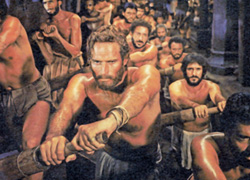
"Galley Slave" Scene from BEN HUR (1959)
STARSTOCK/Photoshot/NewsCom.
All Rights Reserved
Thoughts on an imperfect legend for
FILMS FOR TWO
by Kris Berggren
There are a couple of ways to consider the late Charlton Heston. Whether he played a historical legend or a solitary cowboy, a loner or a leader, the actor conveyed a screen persona that embodied a certain masculine archetype: the rugged, honorable hero.
He was riveting to watch on screen, handsome, fit, and authoritative, certainly looking the part of the god-like man he often portrayed. His characters often had to call moral decisions quickly, and they lived by a code of honor and ethics that was Biblical in the best senseóa virtuous person who stands up for the poor, the widow, the outcast: dare I say, a mensch. Yet every legend has a shadow side, and Heston the man was no exception.
To attempt an accurate summary of the actorís career, I watched a trifecta of Hestonís sometimes ponderous, but always grand and glorious epics:
THE TEN COMMANDMENTS, EL CID, and BEN-HUR. I viewed another handful of his later, more challenging and surprising work including the 1973 sci-fi thriller
SOYLENT GREEN and the 1968 cult classic PLANET OF THE APES. I also spent time with a couple of Western-themed dramas, a quasi-historical drama
THE FAR HORIZONS based on the Lewis and Clark expedition of 1803, and
WILL PENNY. Finally, I had to see Michael Mooreís 2002 documentary
BOWLING FOR COLUMBINE, which presents Heston for once in a villainous roleóand unfortunately, the one he canít write off as fictional.
|
FAVORITE CHARLTON HESTON
FILMS |
1. SOYLENT GREEN (1973)
2. WILL PENNY (1968)
3. BEN HUR (1959)
4. THE TEN COMMANDMENTS (1956)
5. PLANET OF THE APES (1968) |
|
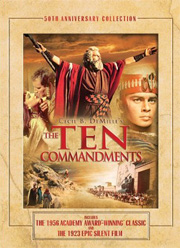
|
Heston is probably best known as Moses in Cecil B. DeMilleís spectacle
THE TEN COMMANDMENTS. As a child I loved catching this on television every year around Easter time. It had much to dazzle a kidís eye, such as the spectacle of the lush, cool pharaohís palace contrasted with the sweaty labor of the Hebrew slaves and the dirt floors of their quarters. There were good and bad guys on both sides, from John Derekís impetuous Joshua and Edward G. Robinsonís hateful Dathan, or Anne Baxter as the jealous and conniving Nefertiri to Yvonne DeCarlo as the virtuous shepherd woman
Sephora.
Iíve always been touched by religious themes, such as how faith motivates resistance to injustice and political or corporate greed. In secular terms, itís about the triumph of the underdog, and either way, it makes for potentially powerful cinema.
|
Hestonís best-actor Academy Award-winning performance in
BEN-HUR, the 1959 epic directed by William Wyler, offers such themes. The title character, Judah Ben-Hur, is like Moses: beset by conflicting loyalties between political expedience and deep-rooted faith, though he is less sure of how to resolve them. Hestonís character again sides with the interests of his community, oppressed by Roman conquerors, over self-interest. Judah must challenge the will of his boyhood friend Messala (Stephen Boyd), now the ambitious military enforcer of the region. Unforgettable scenes include a bare-chested Heston as a galley slave rowing into battle on a Roman ship, and the thrilling, climactic chariot race that solidifies Judahís revenge over
Messala.
The religious theme is Christianized, (thankfully not in a heavy-handed way) as Judah encounters a powerful alternative path preached by a countercultural rabbi. The miracle in this movie is not Mosesí prophetic parting of the Red Sea but the healing of Judahís leprous mother and sister. Jesus is seen only tangentially, and his ideas are promulgated through his actions, such as offering the parched Judah a drink of water in defiance of a Roman soldier, and they are interpreted by others such as Hestonís love interest Esther (Palestine-born actress Haya Harareet).
| And on the subject of love interests, Heston vehemently denied Gore Vidalís public claim that a homoerotic subtext fueled the plot of
BEN-HUR. But in the scene of the emotional reunion of young Judah Ben-Hur with his friend Messalah, returning after a decadeís absence to Judea where he was raised as the Roman governorís son, these two very handsome, athletic looking, men, dressed in sandals and skirts, embrace and gaze on each other with an attraction that oozes chemistry.
In his final three-hour-plus historical drama, Heston played legendary Spanish hero Rodrigo Diaz de Bivar, opposite Sophia Lorenís Jimena (or ďChimŤne,Ē as sheís somewhat inexplicably called in the film). Rodrigo is dubbed
EL CID (meaning ďa man with a vision to be just and the courage to be mercifulĒ) by a grateful Moor whose life he has spared. While thematically and dramatically similar to Hestonís previous epics, this 1961 film plays on the historical element of anti-Muslim prejudice that was part of the political landscape of 11th century Spainówhich has experienced an eerie renaissance in a post-9/11 world. ďWeíve been killing them for years,Ē utters Hestonís Rodrigo, ďand what has it brought us? Peace?Ē
|
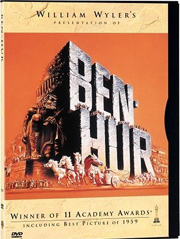
|
These old blockbusters are technically dated. They tend to be slower-paced and stiffer than todayís action adventures, with characters who round their vowels as if theyíre performing Shakespeare, and cheesy techniques like putting white actors in dark makeup to portray ďethnicĒ characters like Indians or Moors. Picture Donna Reed in dark makeup as Sacajawea in
THE FAR HORIZONS, a 1955 portrayal of the Lewis and Clark journey; (Fred MacMurray was Meriwether Lewis to Hestonís William Clark). Still, itís a great example of a mid-century, post-war gloss on historical events. It presents for a burgeoning suburban audience a technicolor, romantic version of American identity shaped by guts, guns, and if not exactly God, the next best thing: the will of President Thomas Jefferson to push past the Louisiana Purchase toward the next horizon of the Pacific and to claim everything in sight for the growing republic.
|
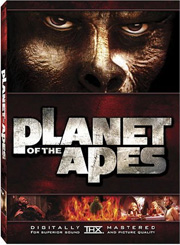
|
If some of Hestonís best roles were as heroic leaders from a distant past, he also played a terrific rugged American individualist. In the late Ď60s and early Ď70s Heston starred in a different sort of film, with a different sort of protagonist: the rugged individualist rather than the charismatic leader.
PLANET OF THE APES is the cult classic in which Hestonís astronaut George Taylor winds up on a planet populated by apes who speak English and dominate the mute and primitive humans there. Taylor manages to circumvent his captors with the help of sympathetic simian researchers played by Roddy MacDowell and Kim Hunter. Iíd only seen the sequels as a kid, but they pale in comparison to this original in the series with its harrowing conclusion.
|
| Also in 1968 Heston made
WILL PENNY, an old-fashioned Western. He called it his personal favorite, and it came in second on my list. Iím a sucker for a Western, and heís at the top of his form here, showing a nice range of his trademark manly self-reliance along with real chemistry with the terrific Joan Hackett as Catherine Allen (a down-on-her-luck widow stuck for the winter on her journey westward with her young son). The man and boy develop a tender father-son relationship both have missed in their lives. But the twisted religious tyrant Preacher Quint (Donald Pleasance) and his brood of mean sons threaten Penny and Allenís lives. |
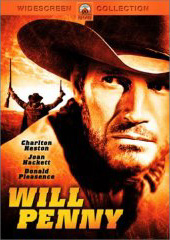
|
|
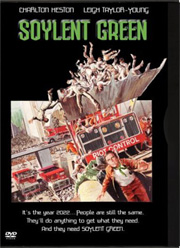
|
Then thereís 1973ís
SOYLENT GREEN. Surprising and suspenseful, the film is about a futuristic dystopian society. Many of New York Cityís 40,000,000 people in 2022 sleep in tenement hallways and abandoned churches. There are curfews, high unemployment, and misery everywhere. Global warming has set in, and thereís no such thing as real food. Everybody save the very wealthy subsists on and vies for limited supplies of the manufactured food product made from ocean plankton, Soylent. It comes in processed squares of red, yellow, and, best of all, (and available only on Tuesdays) Soylent Green. Hestonís Detective Robert Thorn is indeed a thorn in the side of the ineffectual police department, as he investigates the homicide of a rich businessman, in a case that leads him to discover the horrible truth about Soylent Green. Thorn isnít so squeaky clean here; heís not above lifting fresh food, a bottle of whiskey, and a bar of soap from the murder scene: the murdered manís stylish apartment. Edward G. Robinson is marvelous in his last film role as Sol Roth, a police researcher and confidant who collaborates with Thorn. I picked this as my favorite Heston film because I found it surprising and suspenseful, with a still-salient political message about the evils of corporate greed. I also felt it stretched Heston beyond his usual white-hat role to a more nuanced sense of morality. |
Charlton Heston was born October 4, 1924 in Evanston, Illinois, but he spent much of his childhood in a small Michigan town where he hunted and fished. (Moore used their shared rural Michigan roots and National Rife Association membership to gain Hestonís confidence as he sought an interview for his film
BOWLING FOR
COLUMBINE.) Heston returned to Winnetka, Illinois with his mother and stepfather and attended New Trier High School, where the budding actor began to learn his craft. He attended Northwestern University, where he studied drama and met his wife, fellow actor Lydia Clarke. They were married for 64 years, until his death on April 5, 2008.
Over time, Hestonís political views began to shift, along with the kind of film roles he accepted. Once a liberal Democrat, Heston had campaigned for Adlai Stevenson and John F. Kennedy, he marched twice with Martin Luther King. Jr. (including at the 1963 Washington march), he campaigned for the gun-control act of 1968 (after Robert F. Kennedyís assassination), and he opposed the Vietnam War and McCarthyism. Ironically, Hestonís politics shifted seismically over the years, and the actor became a Ronald Reagan ally and staunch conservative, most notably serving as four-term president of the National Rifle Association. ďIt is essential that gun owners unite in an active, growing force capable of flexing great muscle as the next millennium commences,Ē Heston declared.
| Itís unfortunate that Hestonís long and illustrious career is marred by the actorís right-wing political commitments, notably portrayed in
BOWLING FOR COLUMBINE. Maybe the man internalized some of the onscreen demonic forces with which he wrestled so capably: the effects of threats like overpopulation, global warming, nuclear holocaust, and scarcity of natural resources. Itís truly chilling to watch footage of the actor raising a rifle above his head just days after the 1999 Columbine massacre with the battle cry: ďthey will have to pry it from my cold, dead hands.Ē
He demonstrates in that documentary an unnerving insensitivity to how negatively his NRA advocacy played after the tragedies like the Columbine shootings, and in the interview with Moore, he displays an unwillingness to even engage in a discussion of the foundations for his position. I suppose a charitable perspective would be to grant him some benefit of the doubt; maybe his judgment was clouded by some of the personal difficulties he faced in his later years, including recovery from alcoholism and the effects of Alzheimerís disease.
|
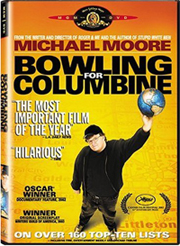
|
Heston the man might have dismissed Mooreís work as agitprop unworthy of a fellow NRA member, but Heston in one of his many wonderful roles as an advocate for the downtrodden and upholder of the vast potential of humanity would more likely have applauded the filmmakerís use of his art to explore the good and evil inherent in the conflict.
© Kris Berggren (6/2/08)
****************
|

|
Kris Berggren is a columnist and contributor to
NATIONAL CATHOLIC REPORTER and MINNESOTA PARENT and writes for other online and print publications. She lives in Minneapolis.
|
|
